|

< Back to Career archive
1984-1989: Back to GTV9
Newly divorced, in February 1984 I returned to the audio department at GTV under the leadership of Col Stevenson for a new season of variety shows hosted by Bert Newton.
I was again in charge of the audio floor crew of myself, Paul McNaughton (now singer and composer Paul Norton) and Andy Gersh (with whom I am still working today). Once again, we had a great studio band headed by Graeme Lyall. As with the Don Lane Show, we had the cream of Australian and International talent trooping through Studio 9 on a regular basis and, during this period, I added to my list of “stars” by being monitor engineer for Stevie Ray Vaughan for his appearance on the Bert Newton Show.
Crawford’s produced two dramas during this period I was working at GTV. The first was “Prime Time”, a show about a current affairs program. This was meant to be a serious drama (unlike what was in reality a “documentary” on current affair programs called “Frontline” and the “documentary” on the public service called “Yes Minister”. I have worked in both institutions, so I know!). A feature of “Prime Time” was that it used the gutted studios which had once been TCS and which had small audio and vision control rooms installed. A couple of bricks were removed from the rear wall of the vision control room so that a camera could be poked inside for the director’s POV. As the same control room was being used to switch the actual recorded shots, it was quite a weird set-up. A lot of the action on Prime Time took place in a pub set (as a lot of real television business is conducted in pubs that made it pretty realistic). However, pub scenes require lots of “extras”. Extras are a necessary evil in the drama business. They are mostly under-employed actors, poorly paid and generally broke. So the opportunity to partake of free coffee and biscuits is a great temptation to any extra. Problem was, the coffee and biscuits were meant for the cast and crew who had much less frequent breaks than the extras. A wily floor manger solved this problem by herding all the extras up to one end of the studio five minutes before a scheduled crew break and threatening them that if they moved from that spot without his permission they would never work for Crawford’s again. It worked.
The second drama was called “Hospital”. It was meant to be one of the “new wave” dramas with lots of hand-held shots, plenty of foreground action crossing in front of the main actors, and a gritty grainy look. It was shot as a pilot and, despite an excellent cast, it was a stinker. It was re-written and re-shot with a second cast, and smelt just as badly. Crawford’s Executive Producer John Barningham was reputed to have collected every copy of both pilots and bulk-erased the lot.
Around this time a failed affair with a work colleague led, for the first (and I hope last) time in my life, to an uncharacteristic loss of stability in my personal life. GTV itself was going through similar trauma, being largely subjugated to the demands emanating from TCN9. GTV lost most of its variety shows with the axing of “The Ernie Sigley Show” on 26 June 1985 and Bert Newton’s “New Faces” on 14 July 1985, leaving “Hey Hey” as the sole remaining show incorporating live music. In May 1987, I left GTV and went freelance. In retrospect, this was a good decision. It got me out of GTV (with its bad memories) for most of the week and freed me from the constraints of the “drudgery shifts” (promos, commercials etc.). It gave me time to pursue a growing interest in the history of our forests and in steam technology. It also meant that I could work on a wider variety of shows for all the television networks. The mainstay of my working life remained GTV (“Hey Hey”, news shifts and “Midday with Ray Martin”, which was in Melbourne on a regular basis).
Nineteen eighty-eight was a busy time for the television industry. It started off with the opening telecast for the Bicentennial Year which was another Peter Faiman spectacular. The telecast went to a huge number of locations around Australia, and my assigned post was Prime Minister Bob Hawke’s garden party at the Lodge in Canberra. I was dispatched to Canberra just after Christmas in 1987 where I was to look after the live sound for Bob’s speech, a performance by John Farnham, and a later cross with Richard Carleton. My local producer was Kate Halliday, a long-time GTV staffer with whom I had worked on many shows. Kate, her boyfriend and I went out to a Chinese restaurant for a meal one night. Canberra is dead enough at the best of times but, between Christmas and New Year it is like a graveyard. We were the only people at the restaurant and, after we had been served, the staff propped the front door open and settled down to play cards, all the time flashing meaningful glances at both us and the front door. I’m ashamed to say it eventually got the better of us and we finished our meal quickly and fled.
I was also invited to be part of a crew put together by AAV to cover the opening telecast from Expo ’88 in Brisbane. When we arrived on site several days prior to the opening, the site was still in construction chaos. We are assigned a large diesel-powered boom to run cables and, after five minutes of being shown how to operate it (no Worksafe certificates in those days!) we were let loose on the site. I remember one day setting off to run some camera cables and audio looms at the far end of the site. It took me two hours to get there after negotiating a huge traffic jam of construction machinery. When I finally reached my destination, I found the footway over which I was to run the cables was freshly painted and there was no way I was going to get the job done. I headed back only to find that a trench had been dug across the only road between me and my destination. There was no other choice but to abandon the boom and go back for it after the trench had been filled in. Even for several days after Expo ’88 had opened, the crowds departed each evening to be replaced by construction crews racing to get their jobs finished before the punters returned next morning. The opening day was a long one. I was first on air with a telecast from the front of the Brisbane Town Hall, after which a procession left for the Expo ’88 site at Southbank. This procession had to cross the Brisbane River and, because it was to have a very vocal aboriginal protest component, it was important to cover this for sound. I was again working with Col Stevenson, and he decided we would rig stereo radio mics from the bridge light stanchions to cover the procession. This was easy enough with daylight, a fresh crew and a police guard directing the traffic. However, when we came to take them down again it was a different matter. It was after midnight, we had all been working for twenty-four hours straight, and the police had abandoned us saying it was too dangerous for them to stay. Nevertheless, the mics had to come down, so off we set with our diesel boom, with only its single flashing yellow light to warn the traffic off. I was very glad when we reached the crest of the bridge and oncoming cars could at last see the bulk of the boom. It was still no picnic suspended twenty metres in the air above the bridge and cantilevered out over the Brisbane River at double this height. Tired hands pressing “sideways” instead of “up” controls could deliver quite a fright. The last of the equipment was delivered back to the trucks just as the sun was rising and we could head off for a couple of hours of well-earned sleep before flying back to Melbourne. I was to return to Expo ’88 later in the year, again with AAV, to cover the concert on the main river stage on behalf of the Australian Pavilion.
As you might gather, there was plenty of freelance work available during the booming late 1980s, but the beginning of 1990 saw all the commercial television stations in receivership after the financial excesses of their profligate owners. In January 1990 I was kept going by undertaking a three-week pilot program for the Historic Places Section of the Department of Conservation, Forests & Lands studying the archaeology and heritage values of two sawmill sites in Gippsland. Apart from a single shift on “Hey Hey”, the expected influx of television work in February never happened. All the networks simply stopped hiring freelancers and production contracted to what their own staff could cope with. At the same time I learned that my ex-wife had a serious substance-abuse problem and, when she went into residential rehabilitation, I became a full-time single parent without a regular income. As my savings dwindled, something had to be done. What was to transpire would keep me gainfully employed for another two decades.
Next page >
|
 |
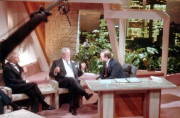
Boom operator’s eye-view of Bert with guests Noel Ferrier and Jimmy Hannan.
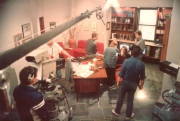
Crawford’s’ “Prime Time”
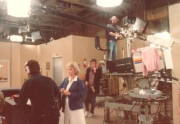
The ill-fated “Hospital” pilot
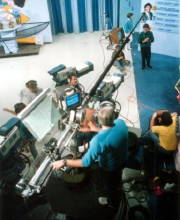
Peter on the boom on “Hey Hey It’s Saturday”
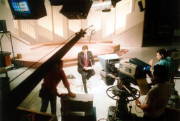
Boom-operator’s eye-view of the opening remarks on “Midday with Ray Martin”
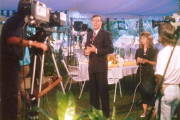
Cross to Richard Carleton at The Lodge during the monster opening telecast of the Bicentenary Year

OB engineer Charlie Cole and sound engineer Chris Doyle in “that” boom at Expo ’88 in Brisbane
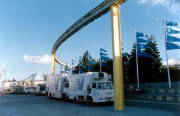
The AAV-Metropolis Audio trucks under the monorail for the opening telecast of Expo ’88 in Brisbane
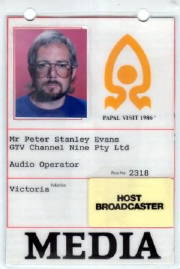
My pass for the Papal visit in 1986. As myself and a cameraman wore special tabards allowing us to be within one metre of the Pope, I had to sign a document absolving the Vatican if they had to accidentally shoot me in his defence
|
